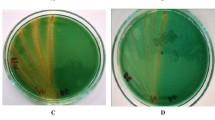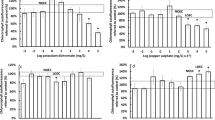Abstract
Siderophores, a family of biogenic metal chelating agents, play critical roles in the biogeochemical cycling of Fe and other metals by facilitating their solubilization and uptake in circumneutral to alkaline oxic environments. However, because of their small concentrations (ca. nM) and large number of molecular structures, siderophore detection and quantification in environmental samples requires specialized equipment and expertise, and often requires pre-concentration of samples, which may introduce significant bias. The “universal” CAS assay, which was originally designed for use in bacterial cultures, quantifies the iron chelating function of a pool of siderophores but only at concentrations (>2 µM) well above the concentrations estimated to be present in marine, freshwater, and soil samples. In this manuscript, we present a high sensitivity modification of this universal assay (HS-CAS) suitable for detecting and quantifying siderophore activity in the nM concentration range, allowing for direct quantitation of siderophore reactivity in transparent aqueous samples.






Similar content being viewed by others
References
Ahmed E, Holmström SJM (2014) The effect of soil horizon and mineral type on the distribution of siderophores in soil. Geochim Cosmochim Acta 131:184–195. doi:10.1016/j.gca.2014.01.031
Alexander DB, Zuberer DA (1991) Use of chrome azurol S reagents to evaluate siderophore production by rhizosphere bacteria. Biol Fertil Soil 12:39–45
Almaraz N, Whitaker AH, Andrews MY, Duckworth OW (in review) Assessing biomineral formation by iron-oxidizing bacteria in a circumneutral creek
Brausam A, van Eldik R (2012) Advances in the mechanistic understanding of selected reactions of transition metal polyaminecarboxylate complexes. In: van Rudi E, Ivana I-B (eds) Advances in inorganic chemistry, vol 64. Academic Press, Cambridge, pp 141–181. doi:10.1016/B978-0-12-396462-5.00005-2
Bylund D, Norstrom SH, Essen SA, Lundstrom US (2007) Analysis of low molecular mass organic acids in natural waters by ion exclusion chromatography tandem mass spectrometry. J Chromatogr A 1176:89–93. doi:10.1016/j.chroma.2007.10.064
Callahan JH, Cook KD (1984) Mechanism of surfactant-induced changes in the visible spectrometry of metal–chrome azurol s complexes. Anal Chem 56:1632–1640. doi:10.1021/ac00273a022
Cervini-Silva J, Kearns J, Banfield J (2012) Steady-state dissolution kinetics of mineral ferric phosphate in the presence of desferrioxamine-B and oxalate ligands at pH 4–6 and T = 24 ± 0.6 °C. Chem Geol 320–321:1–8. doi:10.1016/j.chemgeo.2012.05.022
Crumbliss AL, Harrington JM (2009) Iron sequestration by small molecules: thermodynamic and kinetic studies of natural siderophores and synthetic model compounds. Adv Inorg Chem 61:179–250
Csáky TZ, Hassel O, Rosenberg T, Lång S, Turunen E, Tuhkanen A (1948) On the estimation of bound hydroxylamine in biological materials. Acta Chem Scand 2:450–454. doi:10.3891/acta.chem.scand.02-0450
Duckworth OW, Holmstrom SJM, Pena J, Sposito G (2009) Biogeochemistry of iron oxidation in a circumneutral freshwater habitat. Chem Geol 260:149–158
Emerson D (2012) Biogeochemistry and microbiology of microaerobic Fe(II) oxidation. Biochem Soc Trans 40:1211–1216. doi:10.1042/BST20120154
Emerson D, Fleming EJ, McBeth JM (2010) Iron-oxidizing bacteria: an environmental and genomic perspective. Annu Rev Microbiol 64:561–583. doi:10.1146/annurev.micro.112408.134208
Essen SA, Bylund D, Holmstrom SJ, Moberg M, Lundstrom US (2006) Quantification of hydroxamate siderophores in soil solutions of podzolic soil profiles in Sweden. Biometals 19:269–282. doi:10.1007/s10534-005-8418-8
Frausto da Silva JRR, Williams RJP (1991) The biological chemistry of the elements. Clarendon Press, Oxford
Gimbert LJ, Worsfold PJ (2007) Environmental applications of liquid-waveguide-capillary cells coupled with spectroscopic detection. TrAC Trends Anal Chem 26:914–930. doi:10.1016/j.trac.2007.08.005
Glass J, Orphan V (2012) Trace metal requirements for microbial enzymes involved in the production and consumption of methane and nitrous oxide. Front Microbiol. doi:10.3389/fmicb.2012.00061
Gledhill M, Buck KN (2012) The organic complexation of iron in the marine environment: a review. Front Microbiol 3:69. doi:10.3389/fmicb.2012.00069
Gledhill M, McCormack P, Ussher S, Achterberg EP, Mantoura RFC, Worsfold PJ (2004) Production of siderophore type chelates by mixed bacterioplankton populations in nutrient enriched seawater incubations. Mar Chem 88:75–83. doi:10.1016/j.marchem.2004.03.003
Harrington JM, Parker DL, Bargar JR, Jarzecki AA, Tebo BM, Sposito G, Duckworth OW (2012) Structural dependence of Mn complexation by siderophores: donor group dependence on complex stability and reactivity. Geochim Cosmochim Acta 88:106–119. doi:10.1016/j.gca.2012.04.006
Harrington JM, Duckworth OW, Haselwandter K (2015) The fate of siderophores: antagonistic environmental interactions in exudate-mediated micronutrient uptake. Biometals 28:461–472. doi:10.1007/s10534-015-9821-4
Haselwandter K, Winkelmann G (1998) Identification and characterization of siderophores of mycorrhizal fungi. Springer Lab Manual Series; Mycorrhiza manual. Springer, Berlin
Haselwandter K et al (2006) Basidiochrome—a novel siderophore of the Orchidaceous Mycorrhizal Fungi Ceratobasidium and Rhizoctonia spp. Biometals 19:335–343. doi:10.1007/s10534-006-6986-x
Holmström SJM, Lundström US, Finlay RD, Van Hees PAW (2004) Siderophores in forest soil solution. Biogeochemistry 71:247–258
Hussein KA, Joo JH (2014) Potential of siderophore production by bacteria isolated from heavy metal: polluted and rhizosphere soils. Curr Microbiol 68:717–723. doi:10.1007/s00284-014-0530-y
Jarosz M, Malát M (1988) Spectrophotometric study of the formation of ternary complexes of iron(III) with some triphenylmethane dyes and cationic surfactants. Microchem J 37:268–274. doi:10.1016/0026-265x(88)90136-1
Kem MP, Zane HK, Springer SD, Gauglitz JM, Butler A (2014) Amphiphilic siderophore production by oil-associating microbes. Metallomics 6:1150–1155. doi:10.1039/c4mt00047a
Kloepper JW, Leong J, Teintze M, Schroth MN (1980) Pseudomonas siderophores: a mechanism explaining disease-suppressive soils. Curr Microbiol 4:317–320. doi:10.1007/bf02602840
Kraemer SM (2004) Iron oxide dissolution and solubility in the presence of siderophores. Aquat Sci 66:3–18. doi:10.1007/s00027-003-0690-5
Kraemer SM, Butler A, Borer P, Cervini-Silva J (2005) Siderophores and the dissolution of iron-bearing minerals in marine systems. Rev Mineral Geochem 59:53–84. doi:10.2138/rmg.2005.59.4
Kraemer SM, Crowley DE, Kretzschmar R (2006) Geochemical aspects of phytosiderophore-promoted iron acquisition by plants. Adv Agron 91:1–46. doi:10.1016/s0065-2113(06)91001-3
Kraemer SM, Duckworth OW, Harrington JM, Schenkeveld WDC (2014) Metallophores and Trace Metal Biogeochemistry. Aquat Geochem 21:159–195. doi:10.1007/s10498-014-9246-7
Kraepiel AM, Bellenger JP, Wichard T, Morel FM (2009) Multiple roles of siderophores in free-living nitrogen-fixing bacteria. Biometals 22:573–581. doi:10.1007/s10534-009-9222-7
Kuhn KM, Maurice PA, Neubauer E, Hofmann T, von der Kammer F (2014) Accessibility of humic-associated Fe to a microbial siderophore: implications for bioavailability. Environ Sci Technol 48:1015–1022. doi:10.1021/es404186v
Kustka AB, Jones BM, Hatta M, Field MP, Milligan AJ (2015) The influence of iron and siderophores on eukaryotic phytoplankton growth rates and community composition in the Ross Sea. Mar Chem 173:195–207. doi:10.1016/j.marchem.2014.12.002
Langmyhr FJ, Klausen KS (1963) Complex formation of iron (III) with chrome azurol s. Anal Chim Acta 29:149–167. doi:10.1016/s0003-2670(00)88596-7
Lemanceau P, Bauer P, Kraemer S, Briat J-F (2009) Iron dynamics in the rhizosphere as a case study for analyzing interactions between soils, plants and microbes. Plant Soil 321:513–535. doi:10.1007/s11104-009-0039-5
Machuca A, Navias D, Milagres AMF, Chavez D, Guillen Y (2014) Effects of metal ions (Cd2+, Cu2+, Zn2+) on the growth and chelating-compound production of three ectomycorrhizal fungi. Interciencia 39:221–227
Macrellis HM, Trick CG, Rue EL, Smith G, Bruland KW (2001) Collection and detection of natural iron-binding ligands from seawater. Mar Chem 76:175–187. doi:10.1016/s0304-4203(01)00061-5
Madison AS, Tebo BM, Luther GW (2011) Simultaneous determination of soluble manganese(III), manganese(II) and total manganese in natural (pore)waters. Talanta 84:374–381. doi:10.1016/j.talanta.2011.01.025
Mawji E et al (2008) Hydroxamate siderophores: occurrence and importance in the Atlantic Ocean. Environ Sci Technol 42:8675–8680. doi:10.1021/es801884r
Moberg M, Holmstrom SJ, Lundstrom US, Markides KE (2003) Novel approach to the determination of structurally similar hydroxamate siderophores by column-switching capillary liquid chromatography coupled to mass spectrometry. J Chromatogr A 1020:91–97. doi:10.1016/s0021-9673(03)01236-6
Mucha P, Rekowski P, Kosakowska A, Kupryszewski G (1999) Separation of siderophores by capillary electrophoresis. J Chromatogr A 830:183–189. doi:10.1016/s0021-9673(98)00907-8
Neilands JB (1981) Microbial iron compounds. Annu Rev Biochem 50:715–731. doi:10.1146/annurev.bi.50.070181.003435
Parker DL, Sposito G, Tebo BM (2004) Manganese (III) binding to a pyoverdine siderophore produced by a manganese (II)-oxidizing bacterium. Geochim Cosmochim Acta 68:4809–4820
Połedniok J, Szpikowska-Sroka B (2012) Spectrophotometric study of colour reaction of vanadium(IV) with chrome azurol s in the presence of cationic and non-ionic surfactants. J Anal Chem 68:45–49. doi:10.1134/s1061934813010085
Powell PE, Cline GR, Reid CPP, Szaniszlo PJ (1980) Occurrence of hydroxamate siderophore iron chelators in soils. Nature 287:833–834. doi:10.1038/287833a0
Pytlakowska K, Zerzucha P, Czoik R (2011) Influence of mixed cationic–nonionic surfactant systems on the spectral properties of ci mordant blue 29 and its complexes with iron(III). Anal Sci 27:555–560
Renshaw JC, Robson GD, Trinci APJ, Wiebe MG, Livens FR, Collison D, Taylor RJ (2002) Fungal siderophores: structures, functions and applications. Mycol Res 106:1123–1142. doi:10.1017/s0953756202006548
Ribas X, Salvado V, Valiente M (1989) The chemistry of iron in biosystems. II: a hydrolytic model of the complex formation between iron(III) and citric acid in aqueous solutions. J Chem Res 1989:2533–2553
Robin A, Vansuyt G, Hinsinger P, Meyer JM, Briat JF, Lemanceau P (2008) Iron dynamics in the rhizosphere: consequences for plant health and nutrition. Adv Agron 99:183–225. doi:10.1016/s0065-2113(08)00404-5
Roden EE et al (2012) The microbial ferrous wheel in a neutral pH groundwater seep. Front Microbiol 3:172. doi:10.3389/fmicb.2012.00172
Schalk IJ, Hannauer M, Braud A (2011) New roles for bacterial siderophores in metal transport and tolerance. Environ Microbiol 13:2844–2854. doi:10.1111/j.1462-2920.2011.02556.x
Schenkeveld WD, Oburger E, Gruber B, Schindlegger Y, Hann S, Puschenreiter M, Kraemer SM (2014) Metal mobilization from soils by phytosiderophores—experiment and equilibrium modeling. Plant Soil 383:59–71. doi:10.1007/s11104-014-2128-3
Schroth MN, Hancock JG (1982) Disease-suppressive soil and root-colonizing bacteria. Science 216:1376–1381. doi:10.1126/science.216.4553.1376
Schwyn B, Neilands JB (1987) Universal chemical assay for the detection and determination of siderophores. Anal Biochem 160:47–56
Semb A, Langmyhr FJ (1966) Complex formation of copper(II) with chrome azurol s. Anal Chim Acta 35:286–292. doi:10.1016/s0003-2670(01)81678-0
Shenker M, Hadar Y, Chen Y (1995) Rapid method for accurate determination of colorless siderophores and synthetic chelates. Soil Sci Soc Am J 59:1612–1618
Shenker M, Hadar Y, Chen Y (1999) Kinetics of iron complexing and metal exchange in solutions by rhizoferrin, a fungal siderophore. Soil Sci Soc Am J 63:1681–1687
Siebner-Freibach H, Hadar Y, Chen Y (2004) Interaction of iron chelating agents with clay minerals. Soil Sci Soc Am J 68:470–480
Sorichetti RJ, Creed IF, Trick CG (2014) The influence of iron, siderophores and refractory DOM on cyanobacterial biomass in oligotrophic lakes. Freshw Biol 59:1423–1436. doi:10.1111/fwb.12355
Sowers TD, Harrington JM, Polizzotto ML, Duckworth OW (2016) Sorption of arsenic to biogenic iron (oxyhydr)oxides produced in circumneutral environments. Geochim Cosmochim Acta (in press)
Springer SD, Butler A (2016) Microbial ligand coordination: consideration of biological significance. Coord Chem Rev 306:628–635. doi:10.1016/j.ccr.2015.03.013
Stintzi A, Barnes C, Xu L, Raymond KN (2000) Microbial iron transport via a siderophore shuttle: a membrane ion transport paradigm. Proc Natl Acad Sci 97:10691–10696
Upase AB, Zade AB, Kalbende PP (2011) Spectrophotometric microdetermination of thorium(IV) and uranium(VI) with chrome azurol-s in presence of cationic surfactant. J Chem 8:1132–1141
van der Helm D, Winkelmann G (1994) Hydroxamates and polycarboxylates as iron transport agents (siderophores) in fungi. In: Winkelmann G, Winge FR (eds) Metal ions in fungi. M. Dekker, New York, pp 39–98
Velasquez I, Nunn BL, Ibisanmi E, Goodlett DR, Hunter KA, Sander SG (2011) Detection of hydroxamate siderophores in coastal and Sub-Antarctic waters off the South Eastern Coast of New Zealand. Mar Chem 126:97–107. doi:10.1016/j.marchem.2011.04.003
Vestin JLK, Norström SH, Bylund D, Lundström US (2008) Soil solution and stream water chemistry in a forested catchment II: influence of organic matter. Geoderma 144:271–278. doi:10.1016/j.geoderma.2007.11.027
Wei G-Z (1992) A chemical tool for the detection of siderophores. Lamar University, Beaumont
Wichard T, Bellenger JP, Loison A, Kraepiel AM (2008) Catechol siderophores control tungsten uptake and toxicity in the nitrogen-fixing bacterium Azotobacter Vinelandii. Environ Sci Technol 42:2408–2413. doi:10.1021/es702651f
Yehuda Z, Shenker M, Romheld V, Marschner H, Hadar Y, Chen Y (1996) The role of ligand exchange in the uptake of iron from microbial siderophores by gramineous plants. Plant Physiol 112:1273–1280
Acknowledgements
We thank Lauren Saal and Tyler Sowers for assistance in method development and sampling. We thank the North Carolina Agricultural Research Service (02440) for support.
Author information
Authors and Affiliations
Corresponding author
Electronic supplementary material
Below is the link to the electronic supplementary material.
Rights and permissions
About this article
Cite this article
Andrews, M.Y., Duckworth, O. A universal assay for the detection of siderophore activity in natural waters. Biometals 29, 1085–1095 (2016). https://doi.org/10.1007/s10534-016-9979-4
Received:
Accepted:
Published:
Issue Date:
DOI: https://doi.org/10.1007/s10534-016-9979-4




